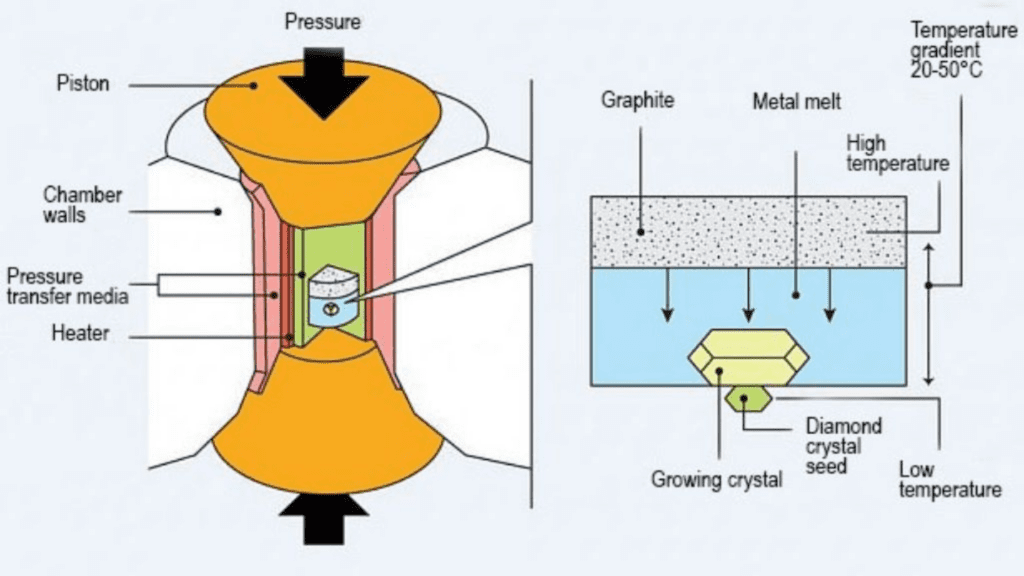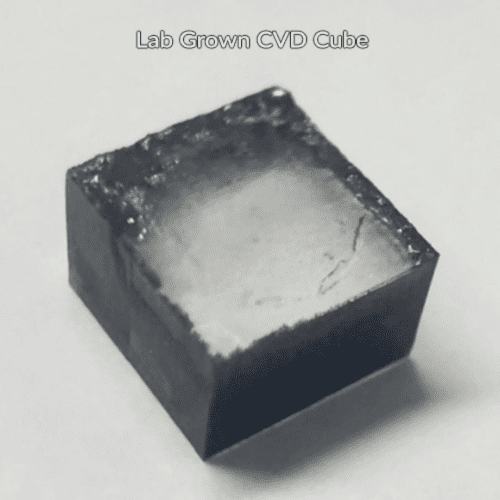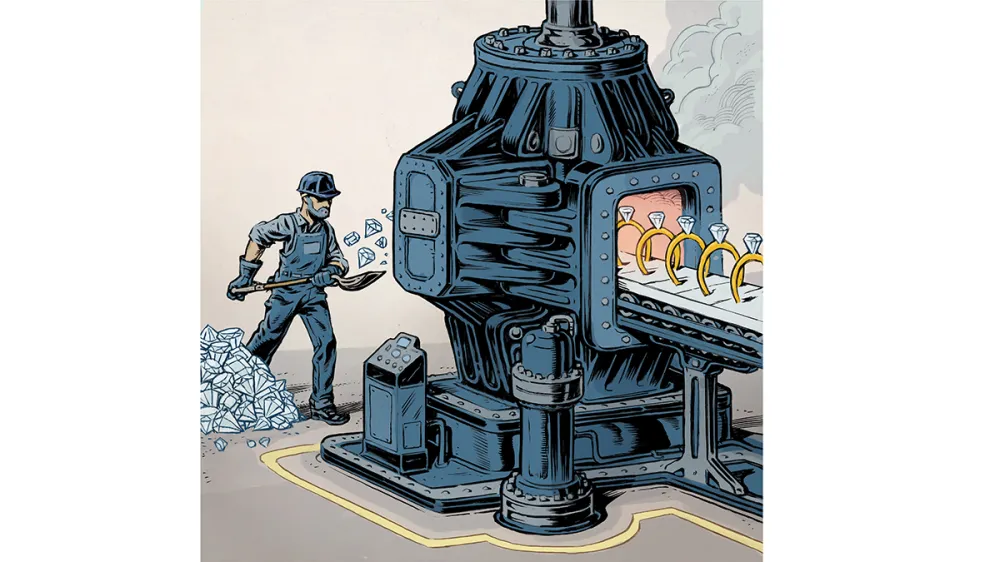How Are Diamonds Made? Natural vs Lab-Created Explained
Two Paths, One Diamond Not all diamonds come from the same place — but they all start the same way. Pure carbon, crystalized under immense pressure and heat. Whether it…
If you own a lab-grown diamond or are exploring options for a lab-grown diamond engagement ring, you may have encountered two common methods for creating these diamonds: the HPHT (High Pressure High Temperature) method and the CVD (Chemical Vapor Deposition) method. Understanding the differences between these two processes can help you make an informed decision when selecting a lab-grown diamond. Here’s an in-depth look at both methods:
The HPHT method is the pioneering technique used to create lab-grown diamonds, first introduced in the 1950s. Initially, this method was used to produce industrial-grade diamonds, but advancements have since enabled the production of gem-quality diamonds.
Most lab diamonds under half a carat are made with the HPHT process. The HPHT process can also enhance the color of diamonds, making them colorless or even producing or enhancing hues like pink, green, blue, or yellow. HPHT annealing treatment is also applied to most CVD diamonds to turn them from brownish to colorless.
In the HPHT process, a small diamond seed is placed in a carbon source, the primary element that constitutes diamonds. There is also a large metal component such as nickel. This setup is then subjected to extreme heat and pressure, mimicking the natural conditions deep within the Earth where diamonds form. The temperature reaches over 2,000 degrees Fahrenheit, and the pressure can exceed 1.5 million PSI (pounds per square inch). Under these conditions, the nickel melts and the carbon crystallizes around the diamond seed, gradually forming a new diamond. The process is similar to the experiments growing salt crystals that you probably did in school chemistry experiments. The growth process is relatively fast, taking a number of hours. Growing larger stones involves dissolving the metal in acids to remove the newly formed crystals and repeating the process.

Image Source: LinkedIn
Explore Lab-Grown Diamonds: Browse an extensive selection of lab-grown diamonds and jewelry from renowned brands like Whiteflash, Blue Nile, and James Allen with PriceScope's comprehensive diamond search.
HPHT diamonds typically form in a cuboctahedral shape, which distinguishes them from diamonds grown with the CVD method. They are also more likely to exhibit a yellowish tint due to exposure to nitrogen during their formation. Additionally, HPHT diamonds often contain metallic inclusions, making them somewhat magnetic—an attribute not found in natural diamonds. This magnetic quality, along with these inclusions, can be a telltale sign that a diamond is lab-grown. Some HPHT diamonds may also have a “blue nuance,” a subtle blue tint caused by boron impurities, which is also responsible for creating rare blue diamonds.
Image Source: Whiteflash
The CVD method is a more recent innovation, developed in the 1980s. This process is designed to replicate the natural formation of diamonds in interstellar gas clouds, albeit under controlled laboratory conditions. Unlike the HPHT method, CVD requires lower pressures and utilizes smaller less expensive equipment.
In the CVD process, a number of flat diamond seeds are placed in a vacuum chamber filled with carbon-rich gases. The chamber is heated to nearly 1,500 degrees Fahrenheit in the presence of high-energy laser-like microwave radiation causing the gases to ionize and turn into plasma. The carbon atoms then begin to settle onto the diamond seed, layer by layer, gradually building up the diamond. A dozen or more rough flat square crystals of 4mm thickness that can be cut to a one carat diamond can take a week or two to grow. It takes only a few more days to grow a 5mm thick crystal to produce a 2 carat polished diamond. This means that larger Lab diamonds are cheaper to grow per carat than smaller diamonds.
If the growth process is interrupted by say a power outage, the crystals often develop a growth plane that can result in slight haziness. If you are buying a lab-grown diamond it’s wise to join the PriceScope lab-grown diamond forum and ask for advice on the stones you have shortlisted. Our forums have savvy consumers who will help you buy the best-performing diamonds.

Image Source: Rêve Diamonds
Both CVD and HPHT diamonds are called Type II, a rare form of natural diamond occurring in around only 2%.

Image Source: Whiteflash
Join the Conversation: Have questions about CVD or HPHT lab-grown diamonds? Connect with other diamond enthusiasts and experts in the PriceScope Online Community. Get advice, share experiences, and make informed decisions with insights from our vibrant community.
Absolutely! Both HPHT and CVD diamonds are genuine diamonds, sharing the same chemical, physical, and optical properties as natural diamonds. When tested with a diamond tester, both will register as diamonds.
To determine whether your lab-grown diamond was created using the HPHT or CVD method, you’ll need to check its grading report. This report, issued by gemological laboratories like the GIA or IGI. The IGI also list treatments as well as the growth method in the “Additional Information” section. For example, an HPHT diamond will be noted as such on the report, possibly with additional details about any color treatments or nuances.
The main method of screening diamonds to identify natural from lab diamonds is the use of long and short wave fluorescence to identify the diamonds Type. Type II diamonds show stronger short wave fluorescence (and phosphorescence) than Type I stones. Also around a half of natural diamonds fluoresce blue when you shine a cheap UV torch on them in the dark.
From a consumer perspective, as long as there is no internal graining in a CVD diamond, there is no visible difference between diamonds grown via the HPHT or CVD methods. Both processes produce stunning, high-quality diamonds that are optically, chemically, and physically identical to the purest natural diamonds. Whether you choose a CVD or HPHT diamond ultimately comes down to personal preference and the specific characteristics you desire in your diamond.

Image Source: Lars Leetaru
Start your lab-grown diamond search, use our special tools to reveal the best cut quality and choose from a collection of loose lab-grown diamonds for sale here:

Retail Diamond Prices Chart Updated Monthly.

Two Paths, One Diamond Not all diamonds come from the same place — but they all start the same way. Pure carbon, crystalized under immense pressure and heat. Whether it…
A Wedding Ring as Unique as Your Love Finding the right wedding ring isn’t just about diamonds or gold – it’s about finding the one that feels right. With hundreds…
So, you’re thinking about lab-grown diamonds? Smart move. They’re just as sparkly as the natural kind but usually cost less. But where do you actually go to buy them? It…

Want to stay updated on the most recent blogs, forum posts, and educational articles? Sign up for Bling News, PriceScope’s weekly newsletter.